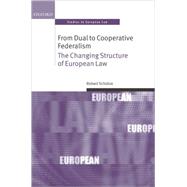From Dual to Cooperative Federalism The Changing Structure of European Law
, by Schutze, Robert- ISBN: 9780199238583 | 0199238588
- Cover: Hardcover
- Copyright: 12/20/2009
What is the federal philosophy underlying the law-making function in the European Union? The federal principle represents a constitutional structure which attempts to find unity in diversity. In federal structures, authority is divided between a centre and the periphery. The two mostinfluential manifestations of the federal principle emerged under the names of dual federalism and cooperative federalism in the constitutional history of the United States of America. While the two variants of federalism share the federal idea of duplex regimen, they differ in how the two levels ofgovernment relate to each other. Which federal model best characterizes the European Union? After an analysis of the federal principle in constitutional history, three lines of arguments are pursued to demonstrate the evolution of the European legal order from a dual federalism towards a cooperative federalist philosophy. The threearguments focus on the scope of the Community's law-making powers in general; the scope of the Community's exclusive powers; and the extent of legislative pre-emption under the Community's shared powers. This transition from dual to cooperative federalism is viewed as a positive development that will benefit both levels of government - the European Union and the Member States - since the ideal of structuring the law-making function according to the problem at hand is more flexible and efficient thanthe idea of mutually exclusive spheres of power. The mechanism of common federal standards supplemented by territorially differentiated national solutions best expresses the idea of unity in diversity.







